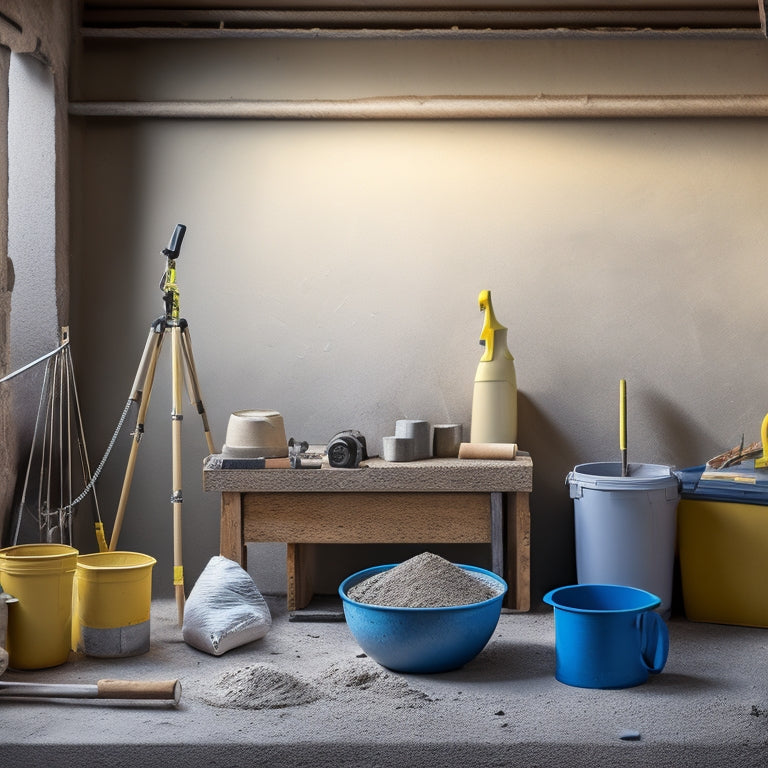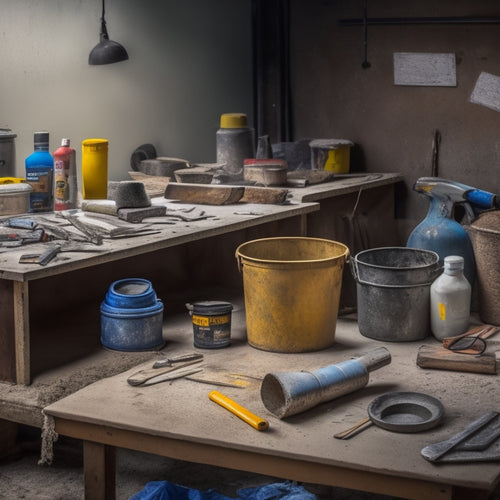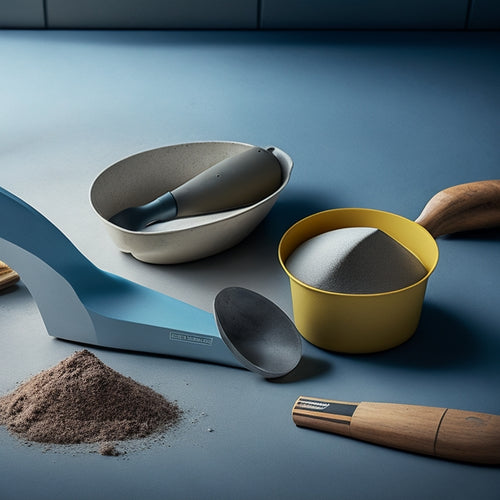
Tools Required for Concrete Block Wall Construction
Share
When constructing a concrete block wall, you'll need a range of tools to guarantee accuracy, efficiency, and safety. Power tools like circular saws, reciprocating saws, and rotary hammer drills are essential, while hand tools like tape measures, levels, hammers, and trowels are also required. Masonry cutting tools, such as block saws and handheld masonry saws, will help you cut blocks to fit, and block laying equipment like spirit levels and string lines will aid in wall alignment. Don't forget safety gear, measuring tools, and mixing equipment to complete the job. With the right tools, you'll be well on your way to building a strong and durable concrete block wall - and there's more to explore to refine your craft.
Key Takeaways
• Essential power tools for concrete block wall construction include circular saw, reciprocating saw, and rotary hammer drill from brands like DeWalt, Bosch, and Makita.
• Hand tools necessary for the project include tape measure, level, hammer, trowel, jointer, and block splitter, which ensure accurate measurements and block placement.
• Masonry cutting tools like cutting block saws, handheld masonry saws, and wet cutting methods enable efficient and precise cutting of concrete blocks.
• Block laying equipment such as spirit level, string line, block alignment tool, and mortar application tools ensure accurate block placement and mortar application.
• Safety gear and accessories, including hard hats, safety goggles, steel-toed boots, and work gloves, are crucial for protecting workers from injuries and hazards.
Power Tool Requirements
You'll need a range of power tools to efficiently construct a concrete block wall, including a circular saw, reciprocating saw, and rotary hammer drill. These tools will help you cut, demo, and drill into the concrete blocks with precision and speed.
When selecting power tools, consider reputable brands such as DeWalt, Bosch, or Makita, known for their durability and performance.
Regular power tool maintenance is vital to guarantee peak performance and extend the lifespan of your tools. Clean your tools regularly, check for wear and tear, and perform routine maintenance tasks such as lubricating moving parts and replacing worn-out accessories. A well-maintained power tool will make your construction process smoother and more efficient.
Additionally, consider the specific features and specifications required for your project. For instance, a rotary hammer drill with a high torque output will be necessary for drilling into thick concrete blocks.
Essential Hand Tool Checklist
Constructing a concrete block wall requires a set of essential hand tools that are vital for measuring, marking, and manipulating the blocks with precision and control.
As you prepare for your project, make certain you have the following hand tools in your arsenal. A tape measure and level will help you guarantee accurate measurements and a straight wall.
A hammer and trowel are must-haves for setting and leveling blocks. You'll also need a jointer or pointing trowel for filling joints and a margin trowel for applying mortar to the blocks.
Depending on the type of block you're using, you may also need a block splitter or block chisel for cutting blocks to fit around corners or obstructions.
Additionally, a putty knife or finishing trowel will come in handy for applying and smoothing out wall finishes such as stucco or plaster.
With these essential hand tools, you'll be well-equipped to tackle your concrete block wall project with confidence and precision.
Masonry Cutting Tool Options
When it comes to masonry cutting tool options, you'll need to decide which type of saw is best for your concrete block wall construction project.
You'll have to evaluate the efficiency and precision required for the job, as well as the potential for dust and debris.
You'll find that cutting block saws, handheld masonry saws, and wet cutting methods each offer unique benefits and drawbacks that you'll need to weigh.
Cutting Block Saws
Two primary types of cutting block saws are available for masonry cutting: dry-cutting saws and wet-cutting saws.
You'll need to decide which one suits your block cutting techniques and project requirements.
Dry-cutting saws are ideal for small-scale projects, as they're lightweight and portable. However, they produce a lot of dust, which can be hazardous to your health.
On the other hand, wet-cutting saws are perfect for large-scale projects, as they're more powerful and efficient. They use a water-cooling system to minimize dust and heat buildup, making them a safer choice.
When choosing a cutting block saw, consider the blade type and quality. A high-quality blade will last longer and provide cleaner cuts.
You'll also need to maintain your saw regularly to guarantee peak performance. Follow these saw maintenance tips: clean the saw after each use, check and replace the blade regularly, and store it in a dry place.
Handheld Masonry Saws
Operating in tight spaces or making precise cuts in masonry materials becomes more manageable with handheld masonry saws, offering you increased flexibility and control in your block wall construction project. These saws are ideal for cutting blocks, bricks, and other masonry materials, and are especially useful when working in confined areas or making curved cuts.
When selecting a handheld masonry saw, consider the following factors:
| Feature | Description |
|---|---|
| Blade Type | Diamond-coated or abrasive blades for efficient cutting |
| Motor Power | High-torque motors for increased cutting speed and accuracy |
| Weight and Ergonomics | Lightweight and ergonomic design for reduced fatigue and improved control |
| Dust Collection | Integrated dust collection systems for reduced mess and improved visibility |
With handheld masonry saws, you can master various masonry techniques, such as cutting and fitting blocks, making precise joints, and creating complex patterns. By choosing the right saw for your specific needs, you'll be able to tackle even the most challenging masonry projects with confidence and precision.
Wet Cutting Methods
By incorporating wet cutting methods into your masonry workflow, you'll be able to make precise cuts in concrete blocks and other materials while minimizing dust and debris. This approach is particularly useful when working with dense materials or making intricate cuts.
To get started, you'll need a wet cutting saw or a diamond blade attached to a circular saw. A reliable water supply is vital to keep the blade cool and lubricated, ensuring a smooth cutting process. This will also help with dust control, reducing the amount of airborne particles and making the work environment safer.
When using wet cutting methods, it's important to maintain a consistent water flow to prevent overheating and extend the lifespan of your blade. Additionally, consider investing in a dust collection system or vacuum to further minimize mess and cleanup.
With the right equipment and techniques, wet cutting methods can become a valuable asset in your masonry toolkit, allowing you to achieve precise cuts and maintain a clean, efficient work site.
Block Laying Equipment Needs
You'll need a set of essential tools to lay concrete blocks efficiently and accurately. For successful block placement techniques, invest in a spirit level, a string line, and a block alignment tool. These will guarantee your blocks are perfectly aligned and your wall is plumb. A rubber mallet or tamping tool is necessary for tapping blocks into place and removing any excess mortar.
When it comes to wall reinforcement methods, you'll require a rebar cutter or rebar bender to shape and cut your reinforcing steel to fit your wall design. A rebar tier or rebar chair is necessary to hold your rebar in place while you lay your blocks. Don't forget a mortar hawk or trowel to hold and apply mortar to your blocks.
Lastly, a mixing bucket, mixing stick, and measuring cups are necessary for mixing and applying the perfect amount of mortar. With these tools, you'll be well-equipped to lay concrete blocks with precision and control, guaranteeing a strong and durable wall structure.
Safety Gear and Accessories
Regularly, construction sites can be hazardous environments, and it's essential that you wear the right safety gear and accessories to minimize the risk of injury when constructing a concrete block wall. You shouldn't compromise on safety, and investing in quality gear will pay off in the long run.
Here are some essential safety gear and accessories you'll need:
| Safety Gear | Description | Purpose |
|---|---|---|
| Hard Hats | Protective headgear | Prevents head injuries from falling objects |
| Safety Goggles | Protective eyewear | Shields eyes from debris and chemical splashes |
| Steel-Toed Boots | Reinforced footwear | Protects feet from heavy objects and tools |
| Work Gloves | Protective handwear | Provides grip and protects hands from cuts and abrasions |
Measuring and Testing Tools
Accurate measurements and testing are essential to guaranteeing the structural integrity of your concrete block wall, so it's important to have the right measuring and testing tools on hand. You'll need a reliable tape measure to guarantee accurate measurements. Make sure to check the tape measure's accuracy regularly to prevent errors. A 25-foot or 30-foot tape measure is usually sufficient for most concrete block wall projects.
In addition to a tape measure, you'll need a level to guarantee your wall is properly aligned. Level calibration is critical to achieving precise results. You can use a spirit level or a laser level, depending on your preference. A level will help you detect any deviations from the desired plane, allowing you to make adjustments as needed.
Other essential measuring and testing tools include a string line, a straightedge, and a measuring square. These tools will help you achieve precise measurements and guarantee your concrete block wall is built to last.
Mixing and Pouring Essentials
Now that you've prepared your site and measured your materials, it's time to focus on mixing and pouring the concrete that will hold your block wall together.
You'll need to assemble the right mixing equipment to guarantee a consistent, high-quality mix.
Mixing Equipment Needed
You'll need a reliable mixer to combine cement, sand, and aggregate in the correct proportions to produce high-quality concrete for your block wall construction.
When selecting a mixer, consider the mixer type and its capacity to handle the required mixing volume. There are two primary mixer types: batch mixers and continuous mixers. Batch mixers are ideal for small to medium-sized projects, whereas continuous mixers are better suited for larger projects that require a constant flow of concrete.
To achieve the best mixing results, it's important to master various mixing techniques. These include validating the mixer is properly calibrated, using the correct mixing sequence, and maintaining the ideal mixing speed. Additionally, you'll need to adjust the mixing technique based on the specific concrete mix design and environmental conditions.
Investing in a high-quality mixer and developing proficiency in mixing techniques will enable you to produce consistent, high-strength concrete for your block wall construction. By doing so, you'll guarantee a durable and long-lasting structure that meets your project's requirements.
Concrete Pouring Techniques
Your concrete pouring technique plays an essential role in guaranteeing the structural integrity and aesthetic appeal of your block wall construction, as it directly affects the concrete's final strength, finish, and overall quality.
To achieve ideal results, you'll need to control the concrete viscosity, which should be neither too thick nor too thin. The ideal viscosity allows for easy flow and leveling without excessive bleeding or segregation.
When it comes to pouring temperature, you should aim for a range between 50°F and 80°F (10°C and 27°C). This temperature range guarantees proper hydration and setting of the concrete. Pouring at extremely high or low temperatures can lead to defects, such as cracking or delamination.
As you pour the concrete, make sure to maintain a consistent flow rate to prevent segregation and guarantee uniform distribution of aggregates. Use a screed board or tamping tool to level and compact the concrete, removing any air pockets or excess water.
Frequently Asked Questions
Can I Use a Regular Drill for Mixing Concrete?
You're wondering if a regular drill can handle concrete mixing. The short answer is, it's not recommended.
Regular drills aren't designed for the heavy-duty mixing required for concrete, and you risk damaging the drill or struggling to achieve a smooth mix.
Instead, consider investing in a drill specifically designed for concrete mixing, such as a hammer drill or a mixing drill with a paddle bit.
These drill types are built for the task, ensuring a thorough and efficient mix.
Do I Need a Permit to Build a Concrete Block Wall?
While you're busy mixing concrete with your drill (we hope you're using the right one!), don't forget to check if you need a permit to build that concrete block wall.
Permit requirements vary by location, so you'll need to research local regulations. Typically, walls over a certain height or those that affect property lines require permits.
Confirm you comply with local codes to avoid costly rework or even demolition.
Get the necessary permits before starting wall construction to avoid headaches down the line.
How Do I Ensure a Straight Block Wall Construction?
To guarantee a straight block wall construction, you'll need to employ precise block alignment techniques.
Start by establishing a level baseline, using wall leveling methods like a spirit level or laser level.
Then, use a string line and a straightedge to guide your block placement, checking frequently to maintain alignment.
Additionally, use a level to verify the wall's plumbness and make adjustments as needed.
Can I Lay Concrete Blocks in the Rain?
Did you know that over 50% of construction delays are caused by weather conditions?
When it comes to laying concrete blocks in the rain, you'll face unique block laying challenges.
Moisture in the air can affect the mortar's bonding strength, leading to structural weaknesses.
To guarantee a strong and durable wall, it's essential to take into account weather considerations, such as wind, temperature, and humidity, before proceeding with block laying.
Wait for a dry spell or take necessary precautions to guarantee a successful construction project.
What Is the Ideal Temperature for Concrete Block Laying?
When laying concrete blocks, you want to guarantee ideal temperature conditions.
Ideally, you're looking at temperatures between 40°F and 90°F (4°C and 32°C) for proper bonding and strength development.
Avoid laying blocks in cold weather, as it can slow down the setting process and compromise the structure's integrity.
If you can't control the temperature, consider using specialized products designed for low-temperature applications.
Conclusion
As you wrap up your concrete block wall construction project, remember that having the right tools is like having the right keys to open a treasure chest - it makes all the difference.
Without them, you'll be stuck outside, unable to access the treasure within.
According to the American Society of Civil Engineers, using the correct tools can increase construction efficiency by up to 30%.
By following this guide, you'll be well-equipped to build a strong and durable concrete block wall that will stand the test of time.
Related Posts
-

3 Best Tools to Buy for Concrete Repair Online
When buying tools for concrete repair online, you'll want to research multiple retailer options to find the best prod...
-

Ergonomic Concrete Tools for Tight Spaces
When you're tackling concrete work in tight spaces, ergonomic tools are your best bet for comfort and efficiency. The...
-

Top Mixing Tools for DIY Concrete Block Laying
When it comes to DIY concrete block laying, the right mixing tools are vital for a strong and durable structure. You'...


